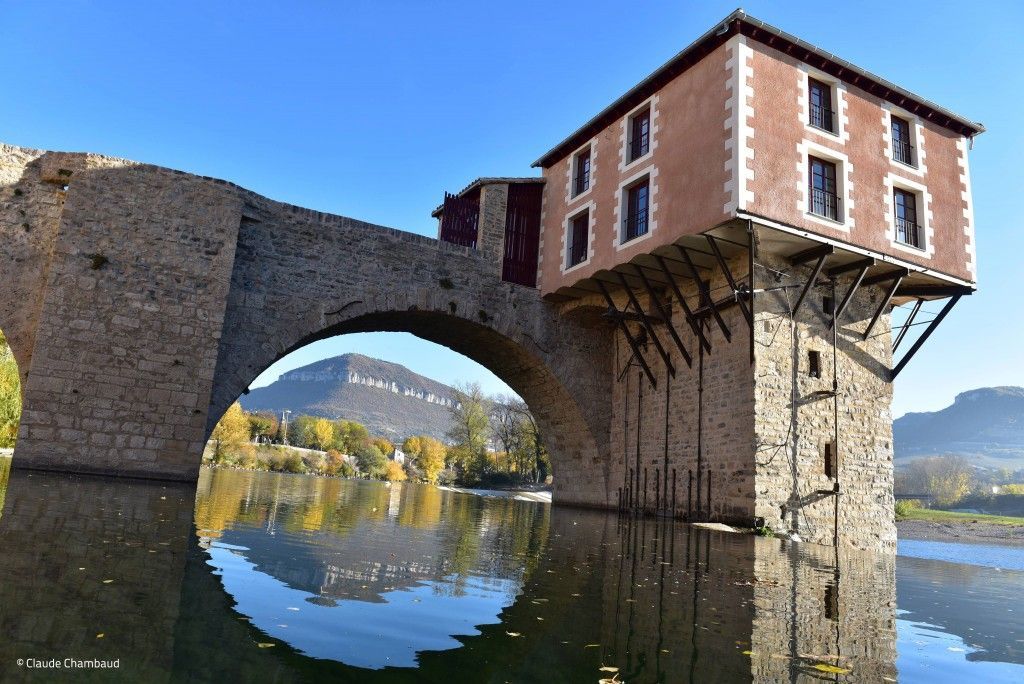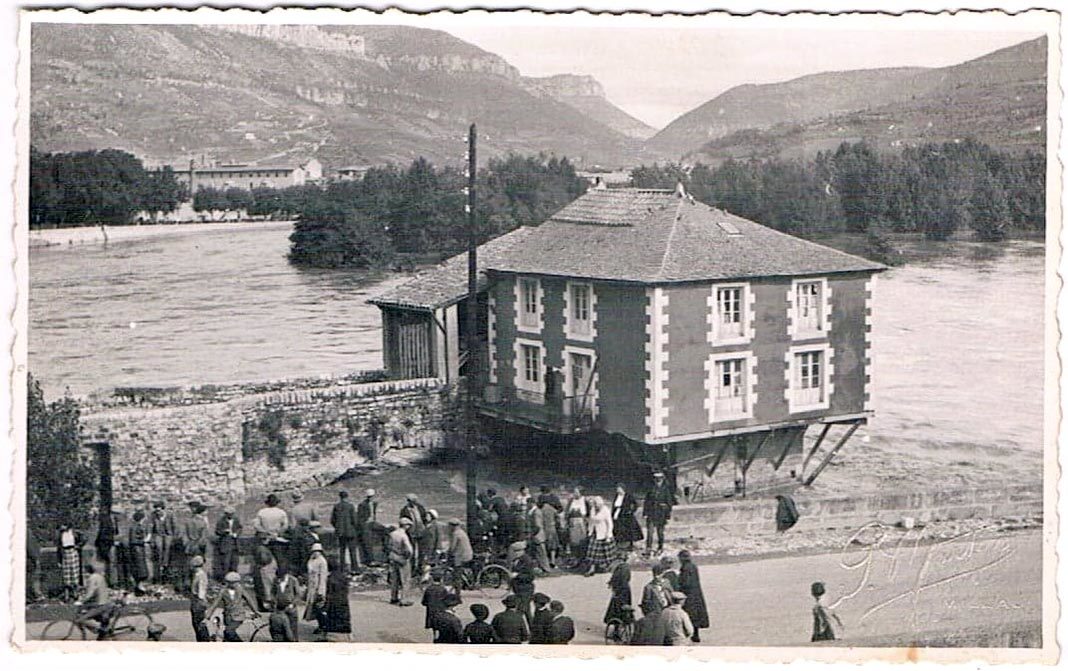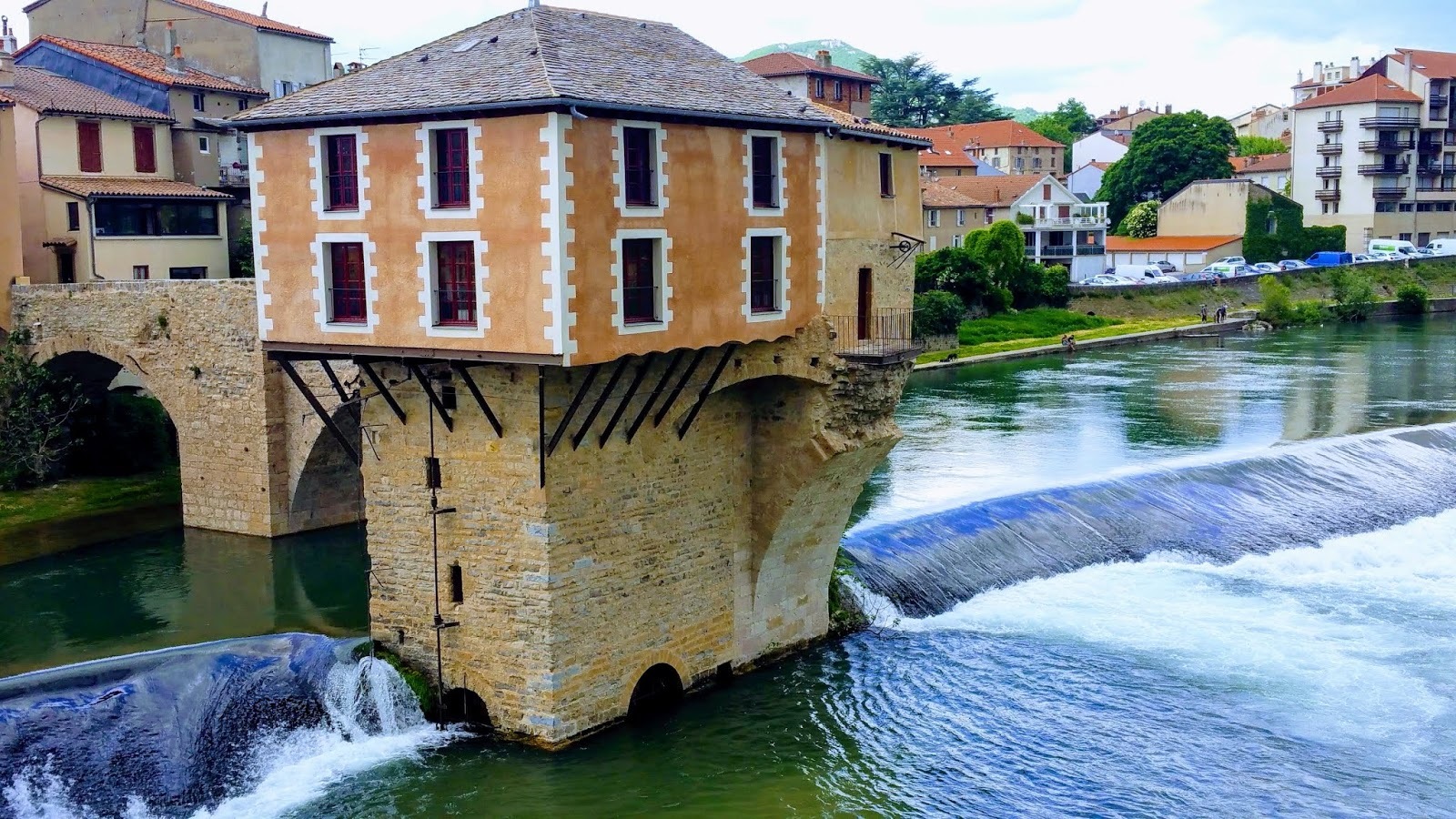
Mentionné pour la première fois en 1371, le premier moulin est probablement élevé à fleur d’eau. Appelé moulin du Roi ou du Pont Vieux en raison de son emplacement, il s’ajoute à celui élevé immédiatement en aval, le moulin de la Roque, peut-être antérieur, et qui partage avec lui la grande chaussée bâtie en amont. Emporté en 1393 et en 1414, le moulin est reconstruit dès cette deuxième date, probablement à l’emplacement qu’on lui connait aujourd’hui, dans la souche
attenante à la deuxième pile du pont.
Moulin à moudre le blé pour les habitants de la ville à l’origine, on lui ajoute un moulin drapier en 1529, alors que depuis un siècle, l’industrie drapière domine la ville.
Dans la première moitié du XVIIe siècle les guerres de Religions entraînent de nouveau des travaux de fortification de la ville et du pont. Des documents d’archives des années 1622 et 1628 montrent que des travaux et des réparations sont entrepris, sur la chaussée, sur le pont ou le moulin durant tout le siècle et au-delà. À l’occasion de leur changement, on apprend qu’en 1631, une des paires de meules à froment est en tuf de Creissels tandis que l’autre, de grès, provient de Saint-Beauzély.

En 1656, la Ville appauvrie cède son « moulin bladier » à Jean-Antoine de Tauriac. Sa famille le conserve jusqu’à la Révolution.
En 1795, le moulin est vendu comme bien national à Fulcrand Fabréguettes, un habitant de Millau. De 1824 à 1829, le moulin est passagèrement équipé d’une meule destinée à la fabrication d’huile de noix. Elle s’élève à « l’emplacement de l’écurie attenante au moulin à blé », sur le tablier du pont arraché depuis 1758.
En 1863, le moulin est vendu à Jacques Sorro qui le modifie l’ensemble, employant de nouveaux matériaux et savoir-faire: il élargit le parapet, surélève le moulin et remplace les poutres de bois par des poutres de fer sur lesquelles reposent des voûtes à l’anglaise.
Des meules en silex de Seine-et-Marne remplacent celle de grès ou de tuf. Trois bluteries et un crible pour nettoyer les blés sont installés et le moulin fonctionne désormais avec cinq moteurs hydrauliques. Dix ans plus tard, la mouture des céréales secondaires semble abandonnée au profit de la fabrication de farine de boulangerie, suite à l’acquisition de trois nouvelles paires de meules à froment, en silex de Dordogne. En 1883, le moulin connait une nouvelle mutation et est converti en moulin à tan. Les écorces broyées servent aux ateliers de tannage des peaux, nécessaire à l’activité peaussière de la ville. Dès 1891, les héritiers de Jacques Sorro y implantent une usine à chamoiser. Une autre étape de l’industrie de la peau est franchie, celle qui permet d’apprêter les peaux nécessaires à la ganterie. Le moulin comprend alors deux foulons, six machines « pour mettre au vent » et des ponceuses.
Pourtant l’année suivante, un moulin à grain avec trois paires de meules et deux bluteries y est de nouveau mentionné. Sans doute l’équipement de 1863 a-t-il été conservé tandis que les nouvelles machines ont été intégrées. Une importante modernisation touche l’ensemble en 1910. Les meules de pierre sont remplacées par des machines modernes et des plansichters, des tamis plats superposés, qui se substituent aux bluteries.

En 1932, pont et moulin sont classés au titre des monuments historiques.
Le propriétaire craignant un ralentissement de son activité, une nouvelle protection est proposée en 1934, ne concernant que le pont. L’activité cesse pourtant en 1937.
Le moulin est vendu à la Ville en 1954 : elle y installe alors le musée puis l’Association des Peintres et Sculpteurs.
Le moulin a été restauré en 2016 par l'architecte du Patrimoine Frédéric Fiore.
Bon geocaching !

Mentioned for the first time in 1371, the first mill was probably built at the water's edge. Called the King's mill or the Pont Vieux mill because of its location, it is added to the one built immediately downstream, the Roque mill, perhaps earlier, and which shares with it the large causeway built upstream. Taken away in 1393 and 1414, the mill was rebuilt from this second date, probably in the location we know today, in the stump
adjoining the second pier of the bridge.
Originally a wheat grinding mill for the town's inhabitants, a cloth mill was added in 1529, while for a century the cloth industry has dominated the town.
In the first half of the 17th century, the Wars of Religion again led to work to fortify the city and the
bridge. Archival documents from the years 1622 and 1628 show that work and repairs were undertaken on the roadway, on the bridge or the mill throughout the century and beyond. On the occasion of their change, we learned that in 1631, one of the pairs of wheat millstones was made of tuff from Creissels while the other, made of sandstone, came from Saint-Beauzély.

In 1656, the impoverished city gave up its “bladier mill” to Jean-Antoine de Tauriac. His family kept it until the Revolution.
In 1795, the mill was sold as national property to Fulcrand Fabraguettes, a resident of Millau. From 1824 to 1829, the mill was temporarily equipped with a millstone intended for the production of walnut oil. It stands at "the location of the stable adjoining the wheat mill", on the deck of the bridge torn up since 1758.
In 1863, the mill was sold to Jacques Sorro who modified the whole, using new materials and know-how: he widened the parapet, raised the mill and replaced the wooden beams with iron beams on which vaults rested. in English.
Grindstones made of flint from Seine-et-Marne replace those of sandstone or tuff. Three sieves and a sieve to clean the wheat are installed and the mill now operates with five hydraulic motors. Ten years later, the grinding of coarse grains seemed abandoned in favor of the manufacture of bakery flour, following the acquisition of three new pairs of wheat millstones, made of Dordogne flint. In 1883, the mill underwent a new transformation and was converted into a tan mill. The barks
The crushed skins are used in hide tanning workshops, necessary for the city's leather industry. From 1891, the heirs of Jacques Sorro set up a chamois factory there. Another step in the leather industry has been taken, that which makes it possible to prepare the skins necessary for glove-making. The mill then includes two fullers, six “wind-winding” machines and sanders.
However, the following year, a grain mill with three pairs of millstones and two millstones was mentioned again. No doubt the equipment of 1863 has been preserved while the new machines have been integrated. A major modernization affected the whole in 1910. The stone millstones were replaced by modern machines and planichters, superimposed flat sieves, which replaced the bluteries.

In 1932, the bridge and the mill were classified as historic monuments.
The owner fearing a slowdown in his activity, a new protection is proposed in 1934, concerning only the bridge. However, the activity ceased in 1937.
The mill was sold to the City in 1954: it then installed the museum there, then the Association of Painters and Sculptors.
The mill was restored in 2016 by Heritage architect Frédéric Fiore.
Have a nice geocaching !